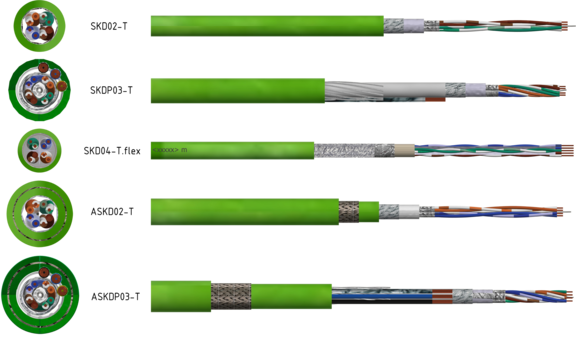Cables for hazardous areas
Our cables and lines were particulary developed to be used in hazardous areas. They are tested for use in idustrial installations and meet the highest quality requirements. They meet the requirements according to DIN EN 60079-14 and the transmission characteristics for Category 6A of IEC 61156-5 Ed. 2. The cables are extremely robust, they have an excellent resistance against mechanical stress, oils greases, mud, sunlight and they are flame retardant and halogenfree. When using the applicable cable gland, it is possible to insert the cables directly into flameproof enclosures. Our high speed cables for industrial ethernet fit for dry, wet or damp rooms.
Unarmoured Cables
Armoured Cables
Video
FAQs
Ex-proof devices must be ATEX certified. Does that also apply to cables and wires?
No. European explosion protection always and exclusively refers to devices and protective systems. Cables and wires do not fall within the scope of Directive 2014/34/EU or the IECEx schemes. As a result, there is no certification or type examination for cables in hazardous areas.
If cables do not have to be certified, what do I have to consider when making a selection if I want to use cables in Ex areas?
Several regulations apply here: If the devices to be connected are in the Ex area, the respective standards for the corresponding type of protection (e.g. flameproof enclosure, intrinsic safety, ...) contain requirements for the respective supply line and its cable entry. General requirements such as flame resistance can be found in 60079-14, which also applies if the cable is only routed through the Ex area. Further information on this question can be found in our brochure go.samcon.eu/fachbericht-kabel and in this video.
Are there general requirements for cables in hazardous areas that I always have to observe?
Yes. In particular, Chapter 9 of 60079-14 postulates technical properties that must be complied with. For example, cables must always be flame-retardant according to 1KW flame, round and without hydroscopic filling materials.
Ex-d enclosures must be flameproof. Are there pressure-resistance requirements for supply lines for Ex-d devices?
Unfortunately, this question is not adequately answered in the standards. In general, one can say that the device - KLE - cable combination must at least withstand the explosion pressure of the housing. For this purpose, we at SAMCON have developed a static and a dynamic overpressure test for combinations of cable glands. Corresponding test reports can be found in the download area of each of our cables.
What is zone carryover and how can it be prevented?
Many lines do not have sufficient gas tightness in the longitudinal direction. In particular, with large Ex-d housings and rapid temperature changes, gases can migrate through the line from the Ex area to the safe area. The best way to prevent this is to select suitable cables in accordance with Appendix E of 60079-14. But zone and pressure barriers can also help here. We would be happy to help you with specific questions about zone transfers.
Do cables in hazardous areas always have to be armored?
NO The international series of standards only postulates protected laying. This can be done in very different ways. National and accident prevention regulations are still important here. We recommend the use of armored cables, particularly in areas with a high mechanical risk, such as offshore installations or underground facilities.
What is the requirement for a minimum length of 3m in the installation regulations?
With a minimum length of 3m, the standard makers assumed the following error scenario: An explosion occurs within the flameproof enclosure. The hot and pressurized explosive gas emits through the pipe and exits at the end. If the connecting cable is very short – e.g. 1m- the gas can still be very hot and well above the ignition temperature of the atmospheric gas. This would lead to a subsequent explosion. After a cable length of 3m, the explosion gas has cooled down to such an extent that there is no longer any risk of thermal re-ignition.
Do barrier glands always have to be used for flameproof devices?
No if the device, the cable and an approved rubber ring sealing screw connection do not limit the pressure resistance of the system, then no barrier gland is necessary. We recommend barrier glands for large ex-d housings and for cables with insufficient longitudinal tightness in accordance with Appendix E of the installation standard.
When do barrier glands for armored cables make sense?
This combination makes sense when the cable is exposed to high mechanical stress and has poor longitudinal tightness, e.g. fiber optic (FOC) cables in offshore areas.
Who is responsible for the cable selection in the hazardous area?
Unfortunately, the responsibility is not defined in the international standards, but only in the national regulations. In Germany, this is the operational safety regulation BetrSiV and the associated TRBsn (technical rules for operational safety). Roughly speaking, it states that the operator of an Ex system is responsible for the selection of cables and lines and thus for system safety. An operator often delegates this responsibility to installation companies specially qualified for this purpose.
Questions about our products
You are not sure which cable is the right one for your application. Perhaps our Topical Booklet and our Cable-Comparison-Matrix may help you for the desicion.
If you have any questions about our products please contact our Sales Team.







